HP OpenVMS Availability Manager User's Guide
7.6.1 OpenVMS CPU Filters
When you select "CPU" on the Filter tabs,
the Availability Manager displays the OpenVMS CPU Filters page (Figure 7-10).
Figure 7-10 OpenVMS CPU Filters
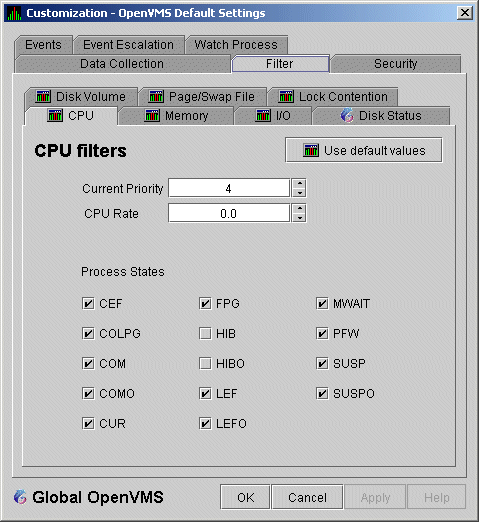
The OpenVMS CPU Filters page allows you to change and select values
that are displayed on the OpenVMS CPU Process States page
(Figure 3-8).
You can change the current priority and rate of a process. By default,
a process is displayed only if it has a Current Priority of 4 or more.
Click the up or down arrow to increase or decrease the priority value
by one. The default CPU rate is 0.0, which means that processes with
any CPU rate used will be displayed. To limit the number of processes
displayed, you can click the up or down arrow to increase or decrease
the CPU rate by .5 each time you click.
The OpenVMS CPU Filters page also allows you to select the states of
the processes that you want to display on the CPU Process States page.
Select the check box for each state you want to display. (Process
states are described in Appendix B.)
When you select Disk Status on the
Filter tabs, the Availability Manager displays the OpenVMS
Disk Status Filters page (Figure 7-11).
Figure 7-11 OpenVMS Disk Status Filters
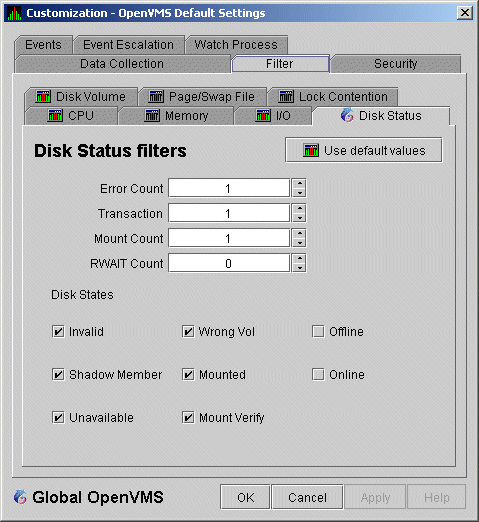
The OpenVMS Disk Status Summary page (Figure 3-14) displays the
values you set on this page.
This page lets you change the following default values:
| Data |
Description |
|
Error Count
|
The number of errors generated by the disk (a quick indicator of device
problems).
|
|
Transaction
|
The number of in-progress file system operations for the disk.
|
|
Mount Count
|
The number of nodes that have the specified disk mounted.
|
|
RWAIT Count
|
An indicator that a system I/O operation is stalled, usually during
normal connection failure recovery or volume processing of host-based
shadowing.
|
This page also lets you check the states of the disks you want to
display, as described in the following table:
| Disk State |
Description |
|
Invalid
|
Disk is in an invalid state (Mount Verify Timeout is likely).
|
|
Shadow Member
|
Disk is a member of a shadow set.
|
|
Unavailable
|
Disk is set to unavailable.
|
|
Wrong Vol
|
Disk was mounted with the wrong volume name.
|
|
Mounted
|
Disk is logically mounted by a MOUNT command or a service call.
|
|
Mount Verify
|
Disk is waiting for a mount verification.
|
|
Offline
|
Disk is no longer physically mounted in device drive.
|
|
Online
|
Disk is physically mounted in device drive.
|
7.6.3 OpenVMS Disk Volume Filters
When you select Disk Volume on the
Filter tabs, the Availability Manager displays the OpenVMS
Disk Volume Filters page (Figure 7-12).
Figure 7-12 OpenVMS Disk Volume Filters
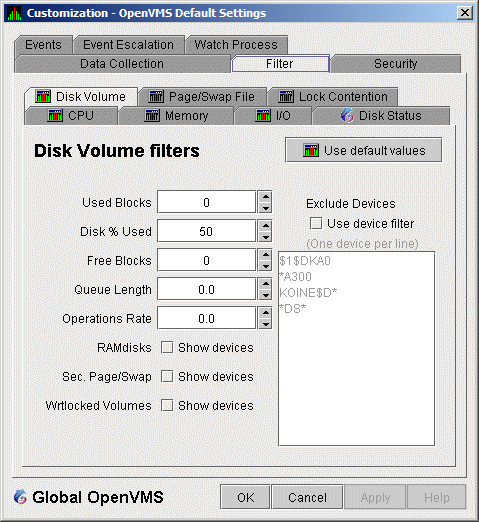
The OpenVMS Disk Volume Filters page allows you to change the values
for the following data:
| Data |
Description |
|
Used Blocks
|
The number of volume blocks in use.
|
|
Disk % Used
|
The percentage of the number of volume blocks in use in relation to the
total volume blocks available.
|
|
Free Blocks
|
The number of blocks of volume space available for new data.
|
|
Queue Length
|
Current length of I/O queue for a volume.
|
|
Operations Rate
|
The rate at which the operations count to the volume has changed since
the last sampling. The rate measures the amount of activity on a
volume. The optimal load is device specific.
|
You can also change options for the following to be on (checked) or off
(unchecked):
- RAMdisks: Show devices
- Sec. Page/Swap: Show devices
Secondary Page or Swap devices are
disk volumes that have "PAGE" or "SWAP" in the
volume name. This filter is useful for filtering out disks that are
used only as page or swap devices.
- Wrtlocked Volumes: Show devices (for example, CDROM devices)
- Exclude Devices: Use device filter
You can exclude specific
disk volumes by listing them in the Exclude Devices text box. You can
use wildcards to specify the disk volumes. Four examples are shown in
Figure 7-12.
7.6.4 OpenVMS I/O Filters
When you select I/O on the Filter
tabs, the Availability Manager displays the OpenVMS I/O Filters page
(Figure 7-13).
Figure 7-13 OpenVMS I/O Filters
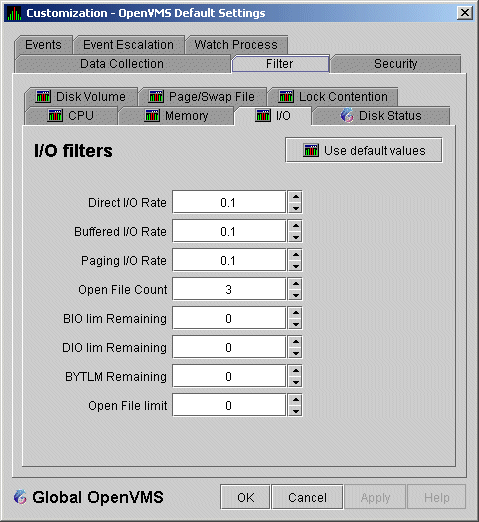
The OpenVMS I/O Summary page (Figure 3-12) displays the values you
set on this filters page.
This filters page allows you to change values for the following data:
| Data |
Description |
|
Direct I/O Rate
|
The rate of direct I/O transfers. Direct I/O is the average percentage
of time that the process waits for data to be read from or written to a
disk or tape. The possible state is DIO. Direct I/O is usually disk or
tape I/O.
|
|
Buffered I/O Rate
|
The rate of buffered I/O transfers. Buffered I/O is the average
percentage of time that the process waits for data to be read from or
written to a slower device such as a terminal, line printer, mailbox.
The possible state is BIO. Buffered I/O is usually terminal, printer
I/O, or network traffic.
|
|
Paging I/O Rate
|
The rate of read attempts necessary to satisfy page faults (also known
as Page Read I/O or the Hard Fault Rate).
|
|
Open File Count
|
The number of open files.
|
|
BIO lim Remaining
|
The number of remaining buffered I/O operations available before the
process reaches its quota. BIOLM quota is the maximum number of
buffered I/O operations a process can have outstanding at one time.
|
|
DIO lim Remaining
|
The number of remaining direct I/O limit operations available before
the process reaches its quota. DIOLM quota is the maximum number of
direct I/O operations a process can have outstanding at one time.
|
|
BYTLM Remaining
|
The number of buffered I/O bytes available before the process reaches
its quota. BYTLM is the maximum number of bytes of nonpaged system
dynamic memory that a process can claim at one time.
|
|
Open File limit
|
The number of additional files the process can open before reaching its
quota. FILLM quota is the maximum number of files that can be opened
simultaneously by the process, including active network logical links.
|
7.6.5 OpenVMS Lock Contention Filters
The OpenVMS Lock Contention Filters page allows you to remove (filter
out) resource names from the Lock Contention page (Figure 3-19).
When you select Lock Contention on the
Filter tabs, the Availability Manager displays the OpenVMS
Lock Contention Filters page (Figure 7-14).
Figure 7-14 OpenVMS Lock Contention Filters
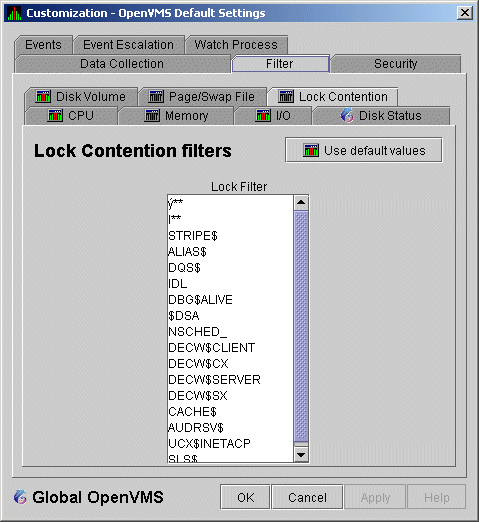
Each entry on the Lock Contention Filters page is a resource name or
part of a resource name that you want to filter out. For example, the
STRIPE$ entry filters out any value that starts with the characters
STRIPE$. To redisplay values set previously, select Use default
values.
When you select Memory Filters on the
Filter tabs, the Availability Manager displays a OpenVMS
Memory Filters page that is similar to the one shown in (Figure 7-15).
Figure 7-15 OpenVMS Memory Filters
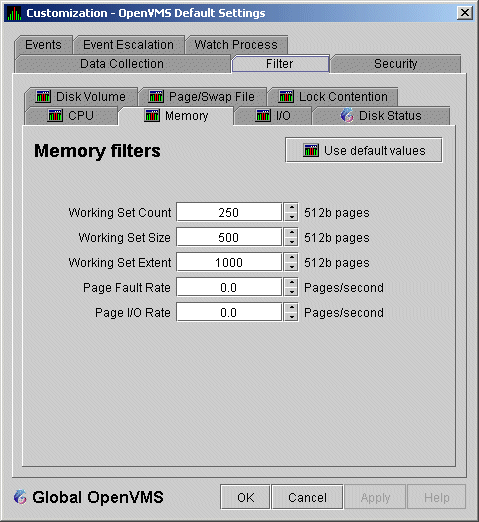
The OpenVMS Memory page (Figure 3-10) displays the values on this
filter page.
The OpenVMS Memory Filters page allows you to change values for the
following data:
| Data |
Description |
|
Working Set Count
|
The number of physical pages or pagelets of memory that the process is
using.
|
|
Working Set Size
|
The number of pages or pagelets of memory the process is allowed to
use. The operating system periodically adjusts this value based on an
analysis of page faults relative to CPU time used. An increase in this
value in large units indicates a process is receiving a lot of page
faults and its memory allocation is increasing.
|
|
Working Set Extent
|
The number of pages or pagelets of memory in the process's WSEXTENT
quota as defined in the user authorization file (UAF). The number of
pages or pagelets will not exceed the value of the system parameter
WSMAX.
|
|
Page Fault Rate
|
The number of page faults per second for the process.
|
|
Page I/O Rate
|
The rate of read attempts necessary to satisfy page faults (also known
as page read I/O or the hard fault rate).
|
7.6.7 OpenVMS Page/Swap File Filters
When you select Page/Swap File on the
Filter tabs, the Availability Manager displays the OpenVMS
Page/Swap File Filters page (Figure 7-16).
Figure 7-16 OpenVMS Page/Swap File Filters
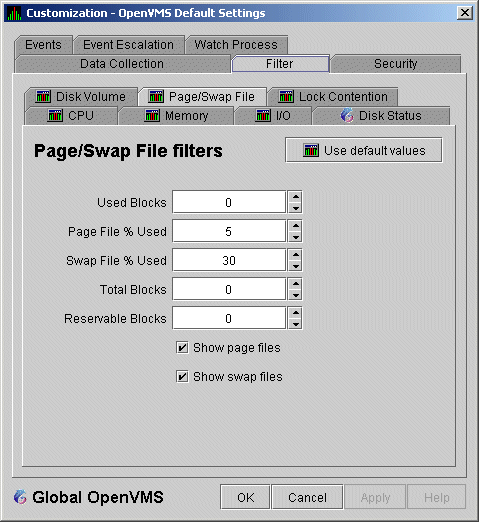
The OpenVMS I/O Summary page (Figure 3-12) displays the values that
you set on this filter page.
This filter page allows you to change values for the following data:
| Data |
Description |
|
Used Blocks
|
The number of used blocks within the file.
|
|
Page File % Used
|
The percentage of the blocks from the page file that have been used.
|
|
Swap File % Used
|
The percentage of the blocks from the swap file that have been used.
|
|
Total Blocks
|
The total number of blocks in paging and swapping files.
|
|
Reservable Blocks
|
Number of reservable blocks in each paging and swapping file currently
installed. Reservable blocks can be logically claimed by a process for
a future physical allocation. A negative value indicates that the file
might be overcommitted. Note that a negative value is not an immediate
concern but indicates that the file might become overcommitted if
physical memory becomes scarce.
Note: Reservable blocks are not used in more recent versions of
OpenVMS.
|
You can also select (turn on) or clear (turn off) the following options:
- Show page files
- Show swap files
7.7 Customizing Event Escalation
You can customize the way events are displayed in the Event pane of the
System Overview window (Figure 2-1) and configure events to be
signaled to OPCOM or HP OpenView. You do this by setting the criteria
that determine whether events are signaled on the Event Escalation
Customization page (Figure 7-17).
Note
Event escalation is the one set of Availability Manager
parameters that you can adjust at all four configuration levels
(Application, Operating System, Group, and Node).
|
When you select any of the customization options, the Availability
Manager displays a tabbed page similar to the one shown in
Figure 7-17.
Figure 7-17 Event Escalation Customization
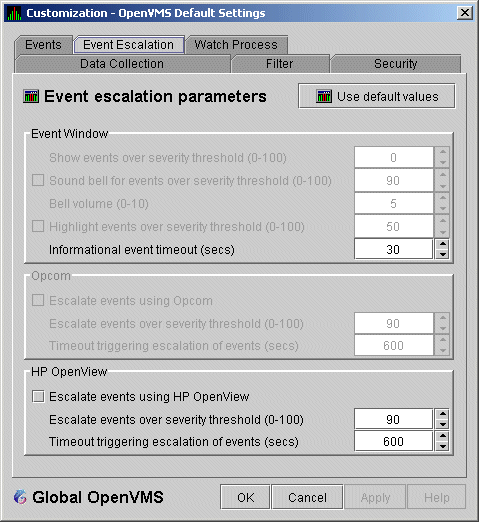
The Event Escalation Customization page contains the following sections:
- Event Window
With the exception of "Informational event
timeout (secs)", the items in this section are dimmed because they
have not yet been implemented. However, you can set the number of
seconds that an informational event is displayed in the Event pane of
the System Overview window (Figure 2-1). (The default is 30 seconds.)
- OPCOM
The items in this section are dimmed if you are not using
an OpenVMS system.
If you are using an OpenVMS system, you can
check the box in the OPCOM section of the page and then enter two
values that work together to determine whether an event is sent to
OPCOM:
- Escalate events over severity threshold (0-100)
The severity
level over which an event might be sent to OPCOM if the second
criterion is met.
- Timeout triggering escalation of events (secs)
The length of
time, in seconds, that an event (over a severity threshold that you
have entered) is displayed in the Event pane of the System Overview
window (Figure 2-1) before the event is sent to OPCOM.
- HP OpenView
Values that you enter have no effect if you do not
have HP OpenView agents installed and configured on your system. (For
configuration instructions, see the next section.)
If HP OpenView
agents are installed and configured on your system, you can check the
box in the OpenView section of the page and then enter two values that
work together to determine whether an event is sent to OpenView:
- Escalate events over severity threshold (0-100)
The severity
level over which an event might be sent to OpenView if the second
criterion is met.
- Timeout triggering escalation of events (secs)
The length of
time, in seconds, that an event (over a certain severity threshold) is
displayed in the Event pane of the System Overview window (see
Figure 2-1) before the event is sent to OpenView.
The following table compares Availability Manager and OpenView
severity levels:
| Availability Manager |
OpenView |
|
0 - 19
|
Normal
|
|
20 - 39
|
Warning
|
|
40 - 59
|
Minor
|
|
60 - 79
|
Major
|
|
80 - 100
|
Critical
|
Important
For an event to be escalated using OPCOM or HP OpenView, the following
conditions must be met:
- On the Event Customizations page (Figure 7-18), the OPCOM or HP
OpenView box must be checked.
- On the Event Escalation page (Figure 7-17), the box in the OPCOM
or HP OpenView section of the page must be checked.
- On the Event Escalation page (Figure 7-17), the severity of an
event must meet or exceed the corresponding severity threshold for the
event, which is shown on the Event Customizations page (Figure 7-18).
- The event must be displayed in the Event pane of the System
Overview window (Figure 2-1) for the required length of time before
the event is sent to OPCOM or OpenView. (The default is 10 minutes.)
|
Figure 7-18 Event Customizations
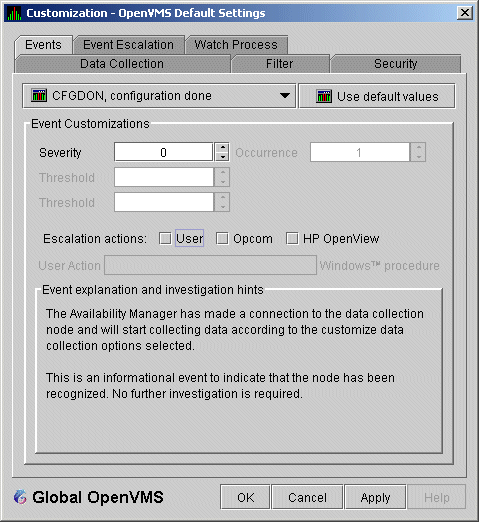
7.7.1 Configuring HP OpenView on Your Windows or HP-UX System
Note
The instructions in this section are for configuring HP OpenView on
Windows. (The configuration for HP-UX systems is very similar;
instructions, however, are not included in this section.)
|
Installing the HP OpenView Server
Prior to configuring HP OpenView, you must perform two steps:
- Install the HP OpenView server software on a Windows or an HP-UX
system. (The Availability Manager can forward events to either a
Windows or an HP-UX system.) For information about performing these
installations, see the HP OpenView documentation.
- Install the HP OpenView template for the Availability Manager on
the HP OpenView server. This is described in the Guide for Setting
Up the Availability Manager to Forward Events to OpenView on the
Documentation page on the Availability Manager Web site:
http://h71000.www7.hp.com/openvms/products/availman/docs.html
|
Configuring the HP OpenView Server and Agents
You can run the Availability Manager on a Windows or on an OpenVMS
system.
If you run the Availability Manager on a Windows system, follow these
steps:
- Configure the HP OpenView server so that the Windows system is a
configured node.
- Deploy the Availability Manager template, AvailMan, to the Windows
system.
The AvailMan template is stored under "Policy
management\Policies grouped by type" in the OpenView Operations window:
HP OpenView\Operations Manager
|
If you run the Availability Manager on an OpenVMS system, follow these
steps:
- Install and configure the HP-OpenView agents on the OpenVMS system
according to the instructions in the document "About OpenVMS
Managed Nodes," which is a link on the HP OpenView Agents for
OpenVMS Web page:
http://h71000.www7.hp.com/openvms/products/openvms_ovo_agent/index.html
|
- Deploy the Availability Manager template, AvailMan, to the OpenVMS
system.
7.7.2 Using HP OpenView on Your System
On the OpenView server you can create or modify policies or templates of
the Open Message Interface group to manipulate events that the
Availability Manager has escalated. For parameters or options fields
set by the Availability Manager, see Table 7-5.
Table 7-5 Parameters and Option Fields Used with OpenView
| Parameter or Option Field |
Description |
|
<$MSG_APPL>
|
Application: "AvailMan" (appears to be case sensitive)
|
|
<$MSG_OBJECT>
|
Object: 6-character event name (example: "HIBIOR")
|
|
<$MSG_GRP>
|
Group: Node originating the event (example: "CMOVEQ")
|
|
<$MSG_SEV>
|
Derived from <$OPTION(SEVERITY)> in the Availability Manager; the
Availability Manager maps SEVERITY to NORMAL, WARNING, MINOR, MAJOR,
CRITICAL
|
|
<$MSG_TEXT>
|
Message text: Event description (example: "CMOVEQ buffered I/O rate is
high")
|
|
<$MSG_NODE>
|
Node running AvailMan
|
|
<$MSG_NODE_NAME>
|
Node running AvailMan
|
|
<$OPTION(NODE)>
|
Node originating the event (example: "CMOVEQ")
|
|
<$OPTION(GROUP)>
|
Group to which originating node belongs (example: "Debug cluster")
|
|
<$OPTION(SEQUENCE_NUMBER)>
|
AM internal event sequence number (example: "14")
|
|
<$OPTION(SEVERITY)>
|
AM event severity (0-100) (example: "60")
|
|
<$OPTION(EVENT)>
|
6-character event name (example: "HIBIOR")
|
|
<$OPTION(TIME)>
|
Original time event posted (example: "15-Aug-2005 14:41:44.164")
|
7.8 Customizing Events and User Notification of Events
You can customize a number of characteristics of the events that are
displayed in the Event pane of the System Overview window
(Figure 2-1). You can also use customization options to notify users
when specific events occur.
When you select the Operating System --> Customize
OpenVMS... or Operating System --> Customize
Windows NT... from the System Overview window
Customize menu, the Availability Manager displays a
tabbed page similar to the one shown in Figure 7-19.
Figure 7-19 Event Customizations

On OpenVMS systems, you can customize events at the operating system,
group, or node level. On Windows systems, you you can customize events
at the operating system or node level.
Keep in mind that an event that you customize at the group level
overrides the value set at a previous (higher) level (see
Table 7-1).
|









